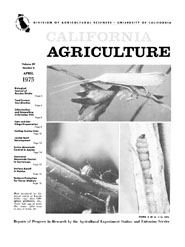


University of California
California Agriculture
|
|||
|
|||

Cover:
Moth introduced for biological control of Russian thistle: (top) adult Coleophora parthenica, 12x; (lower left) egg of moth, 30x; (lower right) larva in stem of thistle, lox.
April 1975
Volume 29, Number 4 News and opinion |
|||
|
University of California, 1301 S. 46th St., Bldg. 478 Richmond, CA
|